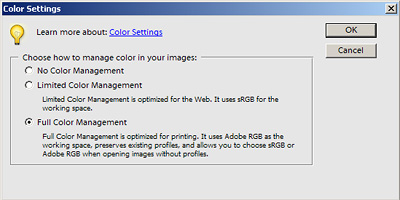AnandTech Guide to Better Photos: Post-Processing
by Stephen Caston on March 18, 2005 3:45 PM EST- Posted in
- Digital Camera
Getting Ready
Before we jump right into editing, there are a couple of things that are very important to do. First, we highly recommend making a backup of your original image. Whether it’s to a CD, DVD, external hard drive, etc., just make sure that you have the original in a safe place and only work on a copy. By doing this, you are giving yourself the option to start over with the original. The second thing to do is to set the RGB color space in Photoshop. By default, Adobe Photoshop will use the sRGB color space. If your original images are in the sRGB color space, you can simply leave it as is (most consumer cameras shoot in sRGB). The sRGB color space is best suited for viewing images on a monitor (such as on a web page). Higher-end cameras often have the option to shoot in either sRGB or Adobe RGB. If your images are in the Adobe RGB color space, you should configure your Photoshop working space as Adobe RGB (1998). The reason for this is that the Adobe RGB color space has a much wider gamut than sRGB – meaning that you can work with a larger range of colors.
Photoshop Elements 3.0
Click to enlarge.
In Photoshop CS, go to the Edit menu and select Color Settings. As you can see, the color settings dialog in Photoshop CS is a bit more involved than it is in Elements. Here, you will just select Adobe RGB (1998) or sRGB from the RGB pull-down menu in the “Working Spaces” section. If you use Adobe RGB to edit your images and you want to display them on the web, you’ll have to remember to convert the image back to sRGB after editing it (which we’ll discuss later). We should point out that if your images were taken in the sRGB space, you won’t gain anything by selecting Adobe RGB.











20 Comments
View All Comments
Bobby Peru - Thursday, June 23, 2005 - link
Would love it if you'd describe batch processing of photos. With Photoshop or, I think the simplest way is running ImageMagick on Linux or Windows Cygwin. You can just whack a whole folder of 100 photos with one simple command line. The underlying DSP algorithms are basically identical to Photoshops's.buttwhacker - Wednesday, April 13, 2005 - link
good article, very informative and i hope u can add to this article.THEJUICE - Tuesday, March 29, 2005 - link
Useful article and enjoy the series. Thanks.vladik007 - Thursday, March 24, 2005 - link
wouldnt it be better just using selection , feather , and adjusting color channels insidethat selection ?red is usually 100% , so you take it down to 5- 10 % , green and blue are best at 50 % in red channel...
never really liked burn tool for red eye ...
stephencaston - Monday, March 21, 2005 - link
#15,I assure you the original image was not doctored. That would defeat the purpose of post-processing ;-) We've updated the page to include a link to the original file. To get the brush to the right size, use the "[" and "]" keys to increase and decrease the brush size. In our example, the Color Replacement Tool is actually desaturating whatever you paint. So, if you can't get the brush to the exact size, it is best to select a smaller brush and paint around inside the pupil until the red-eye is gone. Good luck!
E Scott Channell - Monday, March 21, 2005 - link
I'm curious how the red-eye sample photograph was obtained... the red-eye region appeared to match the paint-brush shape perfectly... Sometimes getting good results takes a wee bit of fiddling so if this was a doctored "good photo" used for illustration it would provide unreasonable expectations as to what a "quick fix" can achieve.Also, if this is a doctored photo the article should make mention of that.
jeffbui - Sunday, March 20, 2005 - link
Good article as well. An amateur has to start somewhere.Gatak - Sunday, March 20, 2005 - link
Actually. Have you tried to do basic stuff like levels, curves and channel mixer with Gimp? The results are inferior to that of Photoshop, especially when you use 16bit/channel mode.AnandTech, you should do a article where you compare photoediting steps between Photoshop and Gimp.
PrinceGaz - Sunday, March 20, 2005 - link
Nice article if you use Photoshop [Elements]. Did Adobe sponsor this article, Stephen?Everything you told people how to do with Photoshop can be done just as easily with Paintshop Pro, the full version of which costs only slightly more than Photoshop Elements, but isn't a cut down version like Elements is. Unless it came free with the camera, or a scanner, you'd have to be crazy to go the Photoshop route just for tweaking your pictures when much cheaper and equally good options are available.
Even splashing out for Paintshop Pro is probably unnecessary for the vast majority of people who will find everything they need available in the freeware image program 'The Gimp'. It might have been better to assume people were using The Gimp rather than Photoshop, as everyone can download The Gimp free of charge (legally).
unhaiduc - Sunday, March 20, 2005 - link
great article, i read every one of your photo tutorials and loved every bit of it!cant wait for the next one :)